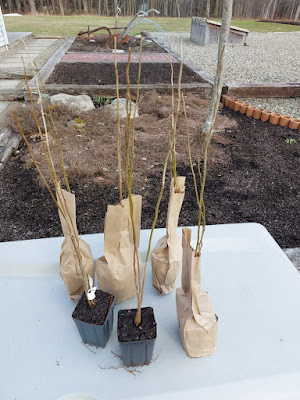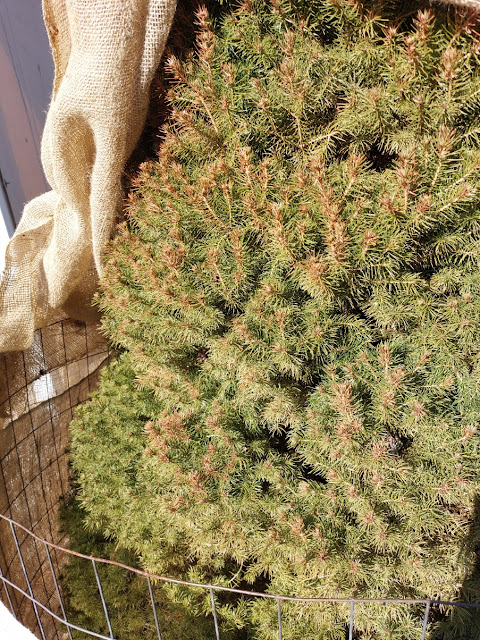In two of my raised beds I have a problem with purslane weeds. Each year I weed it and manage it but the following year it comes up from whatever seeds are left. Last year I intended to use a preemergent control but didn't get around to it. This year we are going to give it a shot.
Thursday, March 31, 2022
PreEmergent Experiment
Sunday, March 27, 2022
Current Situation
This is why we wanted to play outside in the mud when we got some spring like weather.
Thursday, March 24, 2022
Getting a Start on Mulch
We did a little more mulching today, mainly because we didn't want to be indoors. We are supposed so see the return of winter temperatures this weekend so we decided to make the most of it and play outside. We mulched the three London Plane trees in the far side yard. It wasn't really a good day to do it. It rained yesterday and the water table is high.
 |
| This was the bed we did on Tuesday. It is flanked by natural area and needed a lot of mulch. You can see some frozen mulchbergs on the back edge. |
 |
| I wonder if this is the same lonely little honey bee I saw on Tuesday |
Tuesday, March 22, 2022
It Was a Tuesday Afternoon
This morning we got up early to go grocery shopping and at some point the day got away from us. Because that can happen when you're retired. In fact these days its nice when something fun happens spontaneously.
When we got home from errands there was a load of gravel being delivered. And our friend the excavator said that mulch would be ready soon. My husband thought perhaps we ought to try to use up last year's mulch so the bunker would be empty for the new load. We always start on the areas that don't require edging and can be accessed from the driveways when the lawn is still too soft. The beds that are heavily planted with daffodils are also easier to mulch at this stage. I was going to take pictures but I never got around to it.
After we had mulched two beds, we tidied up around the material bunkers and then we sat down at the fire pit. It was just after noon, about fifty degrees and quite still. We were looking at the firepit with its stack of firewood that has been sitting there, unburned, since I stacked it there last August. My husband said that if I thought I could get that soggy wood to burn we ought to open up a bottle of wine and sit by the fire. Because that's what you do when its Tuesday afternoon and you're retired.
After awhile the next door neighbor came over to say "Hi". We poured him a glass of wine. Its his wine after all, he bottled it and that's what you do when its Tuesday afternoon and you're retired.
He went back to his house to get something to show us and we figured he would bring his wife back over. So I went to the house and got a second bottle of wine. Because that's what you do when its Tuesday afternoon and you're retired.
We were discussing how nice it was to be sitting by a campfire on a cool March afternoon, and someone mentioned marshmallows. So I went in the house and got fixins for S'mores. Because that's what you do when its Tuesday afternoon and you're retired.
We had eaten our sweets and some roasted peanuts and the afternoon was growing old. My husband asked the neighbors if they would like to have hot dogs for supper. It has been a long time since any of us had had campfire hot dogs. So hubby went in and got a tray of condiments and hot dogs. Because that's what you do when its Tuesday afternoon and you're retired.
Saturday, March 19, 2022
A Rainy Robiny Kind of Morning
Our good weather is past and now we're back to more Spring-like weather. The yard is rainy, wormy, robiny and muddy. Full of oozy smells.
 |
Thursday, March 17, 2022
Gardening Day #1

 |
| Can you see the two reddish tulip tips? |
Monday, March 14, 2022
Planting Peas
It's almost Pea Planting Time! In the past I've planted peas as early as March 15th. That's not happening this year. We recently had a few inches of snow and that is still on the ground. It is supposed to be a beautiful Spring week so there would undoubtably be opportunity to do it this week but I'm in no hurry. They say to sow peas as early as the soil can be worked. This is basically winter sowing. The seeds will remain dormant and then when conditions are right they are ready, willing and able to sprout. Frost and snow doesn't bother them. The only problem you would have to look out for is the seeds rotting if you have really wet conditions. So let's talk about planting peas.
Some crops like to be a little crowded. They are happier that way. Like pepper plants liking to be able to touch each other, Pea plants like to intertwine. If you give them more space, they will still grow but they won't thrive. And you will be wasting space.
Generally people try to follow the spacing recommendations on the seed packet. Here are the spacing requirements of three different peas that I have grown from three different suppliers:
Johnny's Seeds Penelope Peas: In well-drained soil, sow 1-1 1/2" apart in a 3" band (25 seeds/ft.), 1/2-1" deep. Do not thin
Gurney's Seeds Maestro Peas: 2 - 3 inches between plants, 18 - 24 inches between rows.
Burpee Seeds Garden Sweet:
- Sow 2 inches apart in double rows spaced 6 inches apart with 24 inches between each set of rows.
 |
| Dried seeds for planting this year. |
 |
| Bed #1 photo June 15th First and Second planting seeded 03/15 and 03/29 |
 | ||
| Bed #2 June 15th Second and Third (spaced seeds) planting seeded 03/29 and 04/10 |
 |
| Bed #3 June 15th Third (leftovers from placed) and Fourth planting seeded 04/10 and 04/17 |
Sunday, March 6, 2022
Oh what a beautiful morning,
Oh what a beautiful day,
I've got a wonderful feeling,
Everything's going my way.
Yesterday's high here at the house was 37. When I got up this morning the thermometer already said 55 degrees! Time to go out and poke around.
.JPG)
















































